Small NASA Partner Brings Battery Cooling Innovation To Multi-Billion Dollar Market With Cooler, Lighter and Safer Technology
KULR Technology Group Inc. (OTC:KULR)
KULR Technology Group, Inc. (OTCQB: KULR) develops, manufactures and licenses next-generation carbon fiber thermal management technologies for batteries and electronic systems. Leveraging the company’s roots in developing breakthrough cooling solutions for NASA space missions and backed by a strong intellectual property portfolio, KULR enables leading aerospace, electronics, energy storage, 5G infrastructure, and electric vehicle manufacturers to make their products cooler, lighter and safer for the consumer.

According to Allied Market Research, the global electric vehicle industry is estimated to reach $802.81 billion by 2027, growing at a CAGR of 22.6% from 2020 to 2027. According to Verified Market Research, the Global Lithium Ion Battery Market is projected to reach USD $115.98 billion by 2027, growing at a CAGR of 15.6% from 2020 to 2027. For more information, please visit www.kulrtechnology.com.
Company Highlights
Technology with roots in producing electronic and battery cooling solutions for NASA space missions and transitioning into mass market commercialization.
Key target markets include:
• Aerospace and Defense
• Battery Safety and Testing• Utility Level Energy Storage
• 5G, Cloud Computing, and Consumer Products/Electronics
• Shipping and Logistics (packaging solutions)
• Electric Mobility
• Attractive and scalable business model with high gross margins (73%)
• Robust patent portfolio and 28 customer engagements across multiple industries
• Experienced management team with high insider ownership (+52%
Innovative High-Performance Thermal Management Solutions for Today’s Industries and Emerging Technologies

Invest in companies you believe in.
“It’s far better to buy a wonderful company at a fair price than a fair company at a wonderful price.”
— Warren Buffett
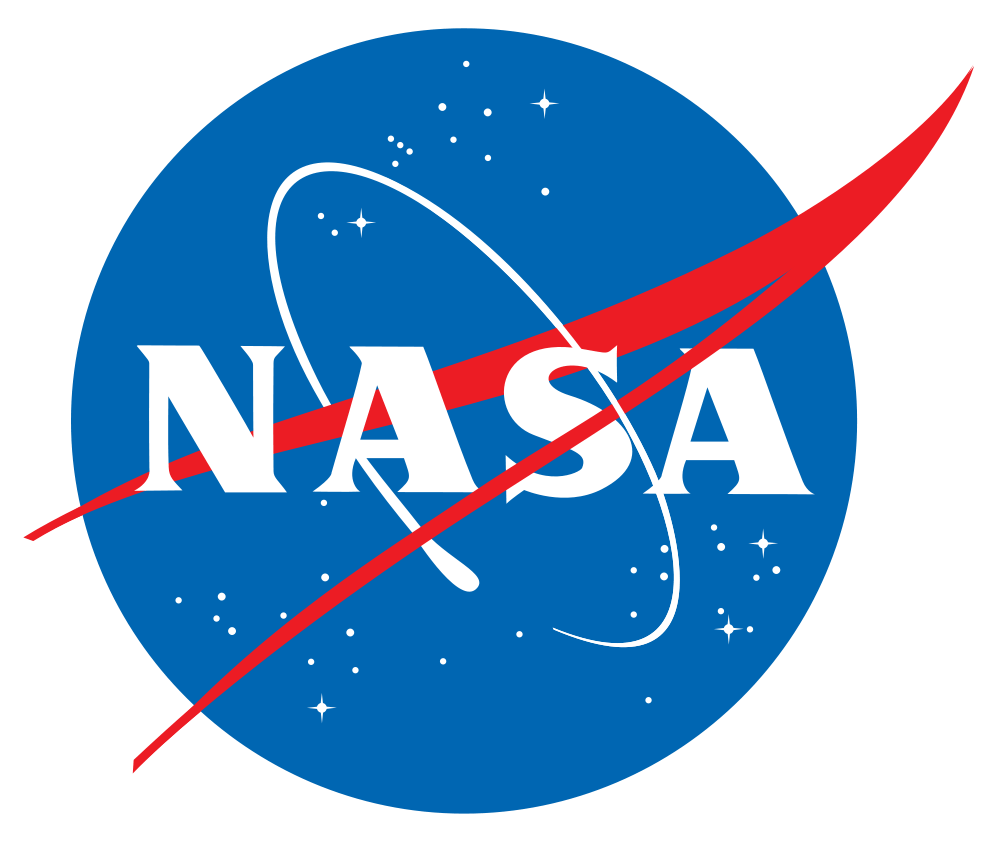
“To date, NASA has not found a design solution with as much promise”
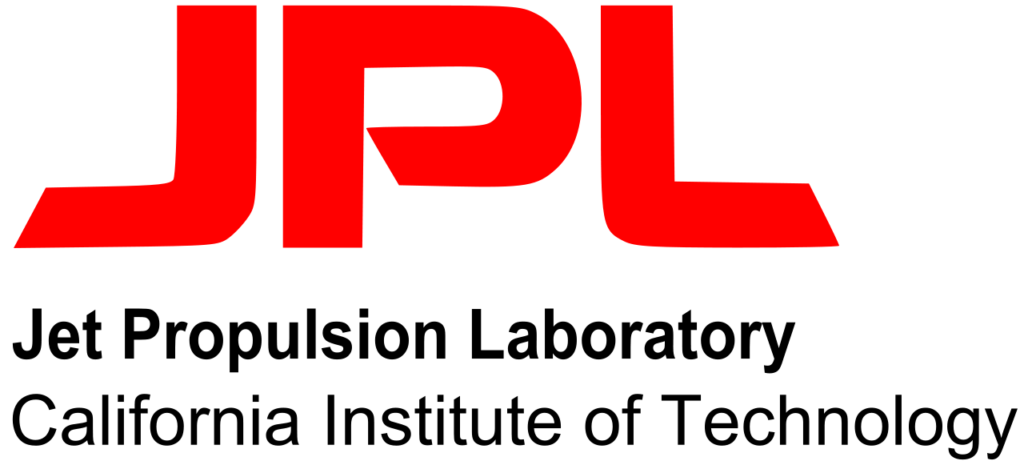
“The KULR team has been an essential part of many of our projects”

“The scalability of this business is huge”
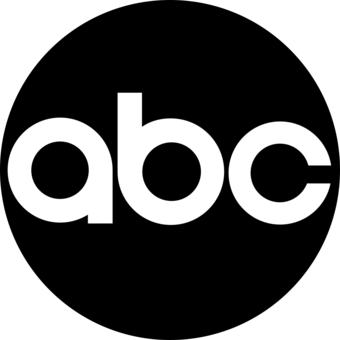
“Thrilled to make a mark on this historic exploration”
Learn More About KULR As News Comes Out at Your Preferred Brokerage Firm
Passive Propagation Resistant (PPR) Lithium-Ion Battery Safety Solutions
▪ Formally launched a PPR battery design solutions for lithium-ion battery cooling and safety in 2020
▪ Design solution provides key features that prevents cell-to-cell thermal runaway propagation and risk of fire and explosion from exiting the battery enclosure
▪ KULR currently works with NASA’s Marshall Space Center and NASA’s Ames Research Center on designs for a crewed space mission
▪ KULR’s HYDRA Thermal Runaway Shield (TRS) technology deployed to the International Space Station – Product development engagements with medical device, electric aircraft, and electric vehicle makers, shipping and logistics solution provider and others
Space Qualified Thermal Interface Material (TIM) and Heat Sink Solutions for Next Generation, Consumer-Facing Mass Market Applications
▪ High thermal conductivity, low thermal resistivity TIMs and heat
sinks keep electronics and electrical products cooler allowing for
improved system performance
▪ Compliant, low contact pressure TIMs allow for greater electronic
and electrical product design flexibility and reliability
Evolution of KULR Technology Group
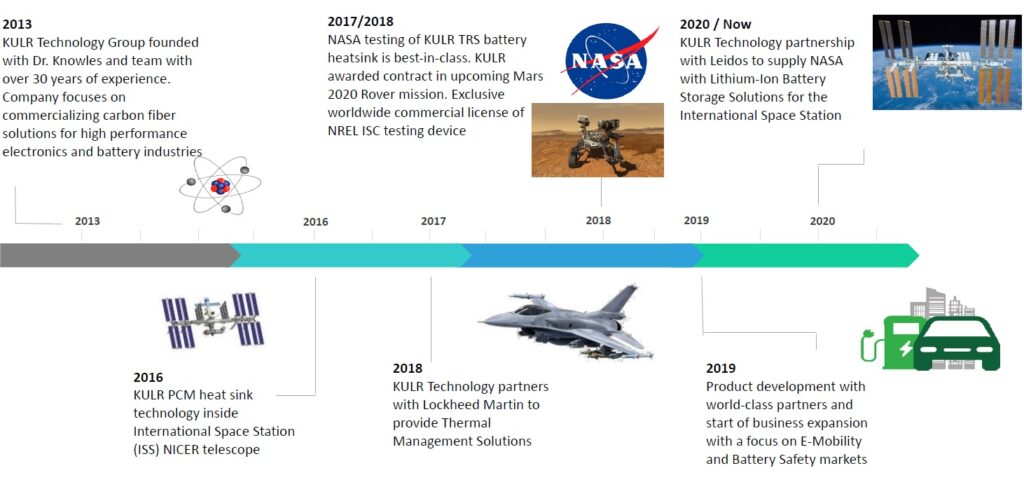
KULR CEO Michael Mo Participates in Live Interview on the "Big Biz Show"
Today KULR announced that its Co-Founder and Chief Executive Officer, Michael Mo, recently participated in a live interview on the “Big Biz Show,” an Emmy-award winning nationally syndicated TV and radio show.A replay of the interview is available for viewing on the Company’s website at https://kulrtechnology.com/videos. During his interview, Mr. Mo discussed: • KULR’s long-time partnership with NASA The Big Biz Show covers current business events, internet-related issues and other hot topics in the business world. The Big Biz Show is seen and heard in over 100 million broadcast TV homes, 150 radio stations in the U.S. and in 175 countries. The Emmy Award winning show was named by TALKERS Magazine as one of the “Top 10 Most Influential Financial Shows.” The Big Biz Show can be seen and heard on YouTOO America Television Network and can be accessed digitally by visiting BizTVClub.com. |
KULR Could Be Just Starting Big Breakout In Red Hot EV And Space Travel Sectors

• Electric Vehicle, EV Battery and Space stocks like TSLA SPCE NIO BLNK PLUG FCEL have been setting record highs almost daily
• KULR Technology Group owns heat management technology that is vital for improved battery performance in electric vehicles and for critical batteries used space missions
• KULR just started breakout on heavy volume last Thursday with shares trading from $1.21 to as high as $1.43 and closing at $1.36.
• Charts suggests strong momentum can take shares to first major level of resistance at $2.50
• A Tier-1 defense contractor recently hired KULR to provide design services for thermal management of hypersonic weapons
• KULR heat management technology has potential for explosive growth from red hot EV companies
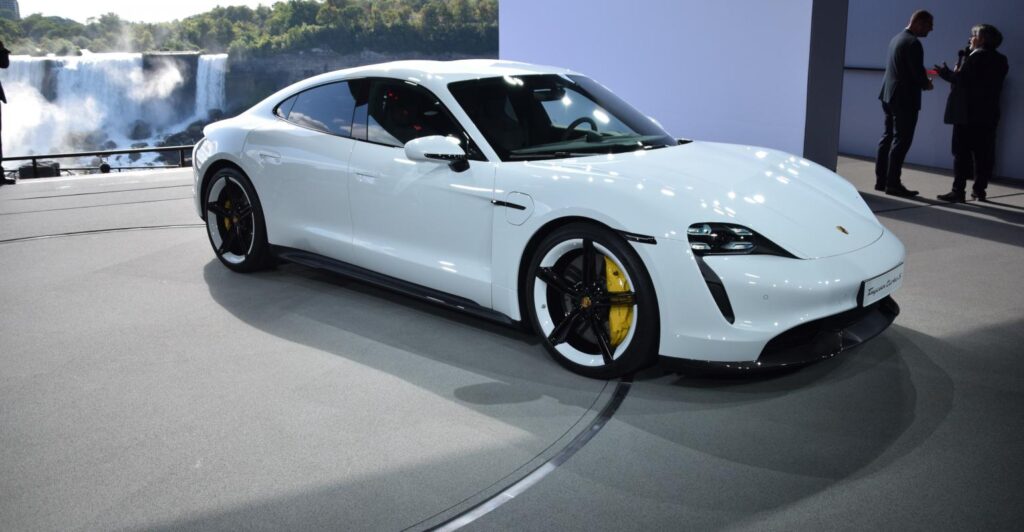
Electric vehicle (EV) stocks have jolted many investors’ portfolios to new heights
iThis is unsurprising as the industry is one of the best performers in the stock market in 2020. The International Energy Agency states that electric vehicle sales accounted for 2.6% of global car sales in 2019. By 2030, this figure could hit 30%. With such a huge slice of the market up for grabs in the next decade, this could very well be a good time to have top EV stocks in your portfolios. From recent events, the Georgia Election undoubtedly gave Tesla and other top EV stocks another boost.
What Is The 2021 Outlook For EV Stocks?
The industry is certainly well-positioned for growth. The certification of Joe Biden as the winner of the U.S. presidential election and the Democrat victory in the Georgia Senate races are two reasons enough to send EV stocks flying. Joe Biden ran on a progressive platform to make the U.S. carbon neutral by 2050. Will there be an EV in every driveway under the Biden Administration? That prospect does not seem too far fetched amid high expectations for heightened industry support moving forward.
Two of the president-elect’s EV policies will play a vital role in the industry. First, Biden will use the full authority of his executive branch to make progress and significantly reduce emissions. He will utilize the Federal government’s procurement system to drive towards 100% clean energy and zero-emission vehicles. Second, Biden’s Year One Legislative Agenda will deploy over 500,000 new public charging outlets by the end of 2030. The agenda will also restore the government’s EV tax credit to target middle-class consumers to increase widespread adoption. With so many exciting developments to come for the EV industry, here are 3 top EV stocks to watch in the stock market today.

KULR Technology Group outlines quarterly achievements and upcoming milestones for 2021
KULR Technology Group Inc. CEO Michael Mo outlines the groups quarterly achievements including its additional contract awards with the International Space Station to supply NASA with safe storage solutions for the Microsoft Surface Pro 5 hybrid notebook computers.
Mo says upcoming milestones to achieve a growth year in 2021 include preparing to up-list to the Nasdaq or the NYSE.
KULR Technology Provides Thermal Management Design Services to Global Aerospace and Defense Manufacturer
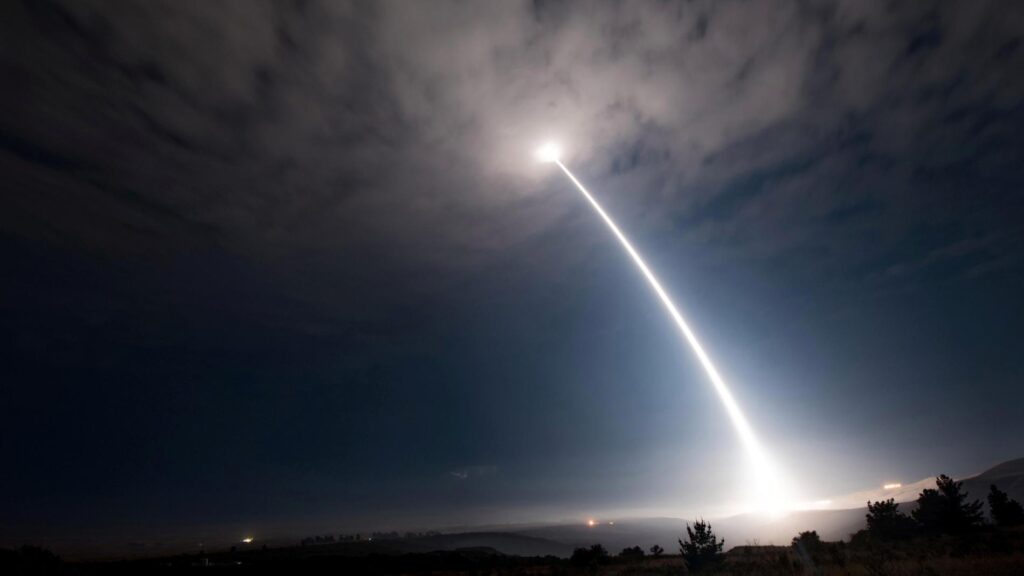
Tier-1 defense manufacturer utilizes KULR’s phase-change heatsink design services for hypersonic applications
Earlier this month, the Company announced that it has provided thermal management design services to a global Tier-1 manufacturer of aerospace and defense technology to improve thermal subsystems needed for increased performance of hypersonic weapons.
A Congressional Research Services report in December 2020 shows that the Pentagon’s FY2021 budget request for all hypersonic-related research is $3.2 billion, up from $2.6 billion in the prior year’s request. Hypersonic strike systems are valued for their unique war-fighting aspects of range, speed, maneuverability, survivability and lethality, according to Mike E. White, the assistant director of hypersonics, Office of the Undersecretary of Defense for Research and Engineering. These features make the development of – and investment in – improved hypersonic systems a priority for the Department of Defense.
“As the national need for long-range airborne vehicles grows, and commercial demonstrations like Space X continue to show the viability of reusable space and sub-orbital vehicles, active and passive heat management become increasingly critical elements to mission success,” says Dave Harden, founder and CEO of The Outpost and KULR advisory board member. “KULR’s closed loop core cooling technology, along with its problem-solving team, are rapidly establishing themselves as essential building blocks for hypersonics, space vehicles, long range stand-off weapons and long loiter drones.”
KULR’s advanced phase-change heatsink design services will assist the manufacturer in the design of hypersonic weapons with longer range and larger kinetic power than existing systems, which are limited by their inability to disperse heat. The ability to keep inner bay components cool within extremely hot outer skin environments – while maintaining highest safety levels – is essential to mission success and market dominance.
“Efficient thermal management is a critical component of hypersonic weapons,” said Michael Carpenter, KULR’s vice president of Engineering. “Our engineers have already designed and built the evaporative cooling device for the DAQ and transmitter modules in the nose of the X-51 Waverider, and from this project we amassed a lot of technical insight. Using this knowledge, it is fairly straight-forward for us to adapt our technology to serve the needs of next-generation hypersonic weapons.”
KULR is Addressing Multi-Billion Dollar Market Opportunities in Battery Technologies, Ranging from Electronic Devices, to Electric Vehicles and Space Exploration.
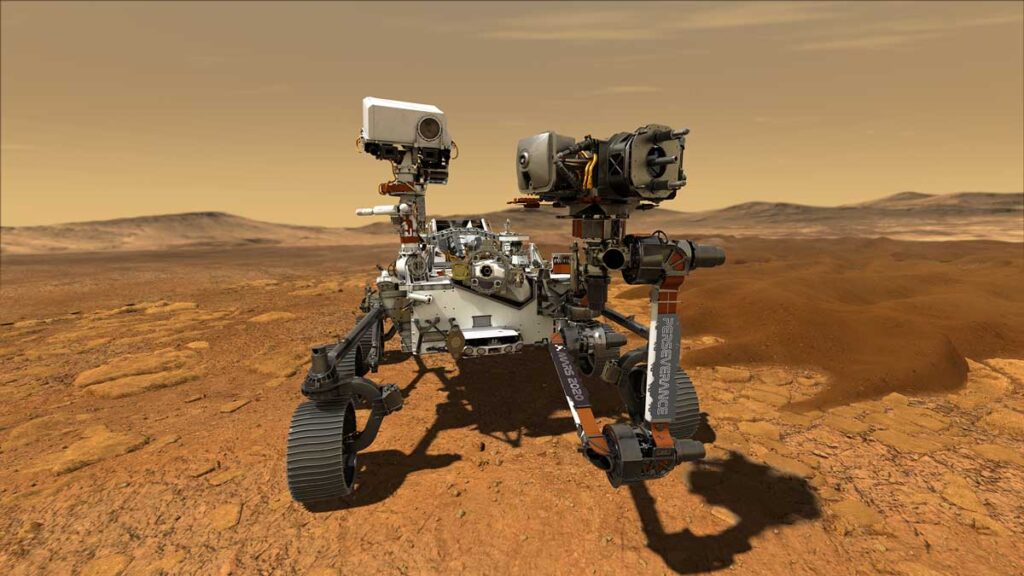
KULR recently announced that its innovative carbon fiber thermal management solutions will be used on the upcoming NASA-JPL 2020 Mars mission as part of the Mars Rover. KULR will provide crucial thermal management for vital components in the Rover as part of the SHERLOC (Scanning Habitable Environment with Raman & Luminescence for Organics & Chemicals) equipment.
The KULR solution includes custom-designed phase change heat sinks designed to absorb and mitigate rapid temperature changes, keeping sensitive components such as lasers and sensors within desired temperature ranges to avoid signal distortion or other complications. During the 2020 Mars Mission, SHERLOC will be mounted on the rover’s robotic arm and use spectrometers, a laser, and a camera to search for organics and minerals that may be signs of past microbial life.
KULR Technology Group and Hazmat Safety Consulting Begin Work to Improve Industry Standards for Commercial Shipments of Batteries
 Moments ago, KULR announced that the Company has commenced work on helping establish updated industry safety standards for lithium battery packaging used to ship batteries commercially. In April 2020, the Company announced a partnership with Hazmat Safety Consulting (“Hazmat”), an organization with over 60 years of combined experience in developing, influencing, and interpreting lithium battery safety regulations for the safe transport of lithium batteries.
Moments ago, KULR announced that the Company has commenced work on helping establish updated industry safety standards for lithium battery packaging used to ship batteries commercially. In April 2020, the Company announced a partnership with Hazmat Safety Consulting (“Hazmat”), an organization with over 60 years of combined experience in developing, influencing, and interpreting lithium battery safety regulations for the safe transport of lithium batteries.
This week, KULR is participating in meetings of the United Nations Transport of Dangerous Goods Sub-Committee Informal Working Group to establish test methods and criteria by which lithium batteries can be more effectively regulated based on their inherent hazards. On September 15, 2020, the Company will present to a subcommittee of the Transportation Research Board on the Prevention of Thermal Runaway Propagation in Lithium Batteries. KULR’s passive propagation resistant (PPR) design solutions prevent dangerous cell-to-cell thermal runaway propagation. KULR’s PPR solutions were recently adopted by NASA for use in future space missions.
Lithium battery fires — such as the incidents that destroyed a UPS plane in 2010 and a FedEx truck in 2016– have increasingly become a public safety concern. The National Transportation Safety Board (NTSB) has called for stricter testing and shipping standards for lithium batteries and submitted safety recommendations to the Pipeline and Hazardous Materials Safety Administration (PHMSA), a division of the Department of Transportation responsible for developing, issuing, and enforcing safety regulations for the transport of hazardous materials, in May 2020.
“Bob Richard, President of Hazmat, who formerly served as the Deputy Associate Administrator for the PHMSA and Chairman of the UN Sub-Committee of Experts on the Transport of Dangerous Goods, will be instrumental in guiding us through the steps required to implement minimum packaging standards required to ship lithium batteries,” said Michael Mo, CEO of KULR. “Our PPR technologies are world-class solutions for preventing dangerous battery fires, and we share the NTSB’s, concerns about current safety standards. Requiring that lithium batteries be shipped in packaging capable of preventing thermal runaway propagation makes logical sense and should be taken into serious consideration by the PHMSA.”
According to Verified Market Research, the global lithium ion battery market was valued at $36.35 Billion in 2019 and is projected to reach $115.98 Billion by 2027, growing at a CAGR of 15.6% from 2020 to 2027.
Last year, NASA used the Company’s PPR technology to safely transport to and store lithium batteries aboard the International Space Station as well as collaborated with KULR on NASA’s high-voltage battery safety guide. Earlier this year, KULR licensed its technologies to Americase, which provides the world’s most widely used return packaging solution for damaged, defective, or recalled batteries.
KULR Technology Group to Participate in United Nations Working Group on Lithium Battery Classification

Company to apply its experience and expertise on UN Working Group’s new lithium battery classification system
Yesterday KULR announced that it will participate in meetings of the United Nations Transport of Dangerous Goods Sub-Committee Informal Working Group to establish test methods and criteria by which lithium batteries can be more effectively regulated based on their inherent hazards. The event will take place in Brussels, Belgium, and virtually online on August 31- September 2, 2020.
Regulatory agencies and international organizations are increasingly concerned with the prevention of battery fires in transport, such as those that have sporadically occurred aboard aircrafts and trucks. The UN Working Group is considering regulations and a new classification system of lithium batteries based on risk factors such as chemistry, form factor, quantities of flame, heat and gas released, and whether they propagate when a cell is intentionally forced into thermal runaway.
A new classification system would require lithium battery manufacturers to test batteries to assess and better understand the risk they pose in transport. The objective is to incentivize battery manufacturers to understand the risks posed and to design safer batteries.
Of particular interest to regulatory bodies are KULR’s passive propagation resistant (PPR) design and proprietary internal short circuit (ISC) battery safety testing technology. As a provider of space-proven expertise in the design, manufacturing, testing and development of innovative risk mitigation solutions to enhance lithium battery safety, KULR strongly supports regulatory initiatives that promote the development of safer lithium batteries.
“KULR agrees with regulators and industry experts that sound battery design, testing and packaging play a critical role in reducing the likelihood of cells and batteries experiencing thermal events. These factors are also crucial in reducing the hazards when a cell or battery experiences a thermal event,” said Michael Mo, CEO of KULR. “Reducing the probability and limiting the effects of mass thermal runaway propagation is an absolute must. KULR is strategically suited to support the UN Working Group’s initiatives and is eager to provide solutions to meet current and future regulatory requirements. We look forward to participating in this incredible meeting to pursue next-level safety standards for today’s battery technology.”
KULR Technology Group Awarded by NASA Marshall Space Flight Center to Build 3-D Printed Battery Systems for Manned and Robotic Space Applications
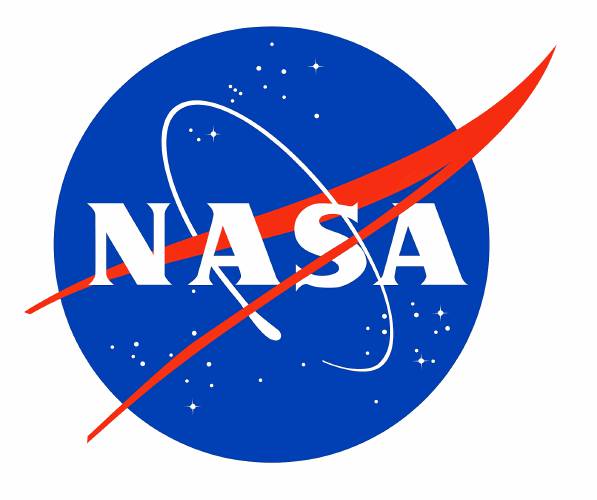
transport and store batteries aboard the International Space Station last year.
“Through our partnership with KULR, we will now have the incredible ability to build space-optimized battery pack systems in-orbit,” said Brandon Lewis, Human Landing System Cross Program Analysis Coordinator. “We take the safety of our astronauts very seriously. KULR’s technologies will enable us to build safer battery packs that prevent dangerous thermal runaway propagation and protect our most valuable assets.”
The ability to 3D print in space has numerous advantages, including the potential to make human space exploration less costly; allowing for extended missions; and reserving cargo capacity for other valuable items and/or equipment.
“The optionality to repair and replace battery packs in space with parts 3D printed in space is a complete game changer,” said Dr. Timothy Knowles, co-founder and chief technology officer of KULR. “3D printing of KULR’s PPR battery design will help lower the costs associated with battery pack transportation for the upcoming Artemis missions, where NASA will build sustainable elements on and around the moon in preparation for an eventual human mission to Mars.”
Development of new 3D technology may enable future space missions to print spare battery packs on demand and en route therefore reducing the cost of transport and reserving cargo capacity
NASA’s Marshall Space Flight Center (MSFC) has awarded the Company a dual-use technology development agreement to build 3D printed battery systems for manned and robotic space applications. KULR’s passive propagation resistant (PPR) and internal short circuit (ISC) technologies will be used to develop 3D printed battery systems that meet the JSC 20793 Revision D safety standard created by NASA for crewed space missions.
“NASA employs highly rigorous assurance and safety standards, especially for our man-rated technologies. KULR’s PPR design solution for future manned and unmanned space missions is an ideal fit for mass design, flexibility and cost, all the while maintaining this safety rigor through battery risks such as thermal runaway,” said NASA MSFC Deputy Chief Technologist John Carr.
Only a handful of groups are working to adapt 3D printing for space application, and NASA’s MSFC is at the forefront of engineering excellence for 3D printing technology. MSFC’s 3D printing expertise, combined with KULR’s proficiency in designing PPR battery packs, establishes the pinnacle in safe battery power systems manufactured in outer space. KULR’s PPR solution demonstrated its efficiency when it was used by NASA to transport and store batteries aboard the International Space Station last year.
“Through our partnership with KULR, we will now have the incredible ability to build space-optimized battery pack systems in-orbit,” said Brandon Lewis, Human Landing System Cross Program Analysis Coordinator. “We take the safety of our astronauts very seriously. KULR’s technologies will enable us to build safer battery packs that prevent dangerous thermal runaway propagation and protect our most valuable assets.”
The ability to 3D print in space has numerous advantages, including the potential to make human space exploration less costly; allowing for extended missions; and reserving cargo capacity for other valuable items and/or equipment.
“The optionality to repair and replace battery packs in space with parts 3D printed in space is a complete game changer,” said Dr. Timothy Knowles, co-founder and chief technology officer of KULR. “3D printing of KULR’s PPR battery design will help lower the costs associated with battery pack transportation for the upcoming Artemis missions, where NASA will build sustainable elements on and around the moon in preparation for an eventual human mission to Mars.”
KULR Revenues Increase 257% on New Customer Growth and Service Projects

Second Quarter 2020 Summary Achievements:
Increased revenues by 257%, driven by two-fold increase in customer transactions
Reduced monthly operating expenses by 20%
Raised $758,000 from the issuance of common stocks, net of issuance expenses
Awarded patents on its NASA-grade Fiber Thermal Interface (FTI) and Thermal Runaway Shield (TRS) solutions
Established new partnerships and supply agreements to implement proprietary thermal heat technology into electric vehicles, energy storage and other commercial applications
Operational Highlights:
KULR was awarded a patent on its Fiber Thermal Interface (FTI), a NASA-grade high-performance thermally conductive carbon fiber material developed for a variety of different applications, including space, automotive and electronics.
KULR was also awarded a patent on its Thermal Runaway Shield, which reduces hazardous risks associated with thermal runaway in lithium-ion battery packs.
The Company partnered with Silicon Valley-based Drako Motors to use FTI for the thermal management system of Drako GTE, a new ultra-high-performance electric supercar.
Dave Harden, former Chief of Strategic Prioritization at the Pentagon, joined KULR’s advisory board.
Signed an agreement with Volta Energy Products to provide passive propagation resistant (PPR) technology for implementation in stationary energy storage modules from the grid.
Launched a PPR battery design solution for space applications, including both trigger and production cells, for lithium-ion battery testing and safety.
Its innovative carbon fiber thermal management solution was used on the Mars 2020 Perseverance Rover SHERLOC instrument.
Partnered with Hazmat Safety Consulting to work with industry and regulatory leaders on PPR battery safety technology due to increased focus and concern on improving public safety from battery fires.
Announced licensing agreement with Americase for use of KULR’s PPR technology and supply of core materials for Americase’s patent-pending battery bag.
Litchfield Hills Research Initiates KULR Technology Group with a "Buy" Rating and Slaps On $5.00 Price Target!

+400% Upside From Here
KULR reported 2Q20 results that were largely as expected, missing our EPS estimate by a penny due to rounding. The company reported an EPS loss of $0.01 on $201,000 of revenue. We had been looking for an EPS loss of $0.00 on $200,000 of revenue. Our 2021 estimates are unchanged
KULR Technology Group develops, manufactures and licenses next-generation carbon fiber thermal management and safety technologies for batteries and electronic systems.
The company has been pulling together solid business relationships with companies that will use KULR products. Those companies, however need to execute on their production plans. For example, subsequent to the end of the quarter announced a supplier partnership with Drako Motors, maker of an electric Supercar and commercialized battery safety technology for Volta Energy’s Whispertech™ energy storage systems. It also announced it was awarded two new U.S. patents.
Both the growth of electric-motor based transportation and demand for increased safety of lithiumion batteries are key drivers for KULR. Semiconductor and other components that control current flow to the motors must manage considerable heat in the process. KULR has what we believe to be better and lighter materials for thermal management.
Attractive valuation. The company has been cutting costs and is targeting cash flow break-even by 4Q20.
Source: http://www.hillsresearch.com/wp-content/uploads/2020/08/KULR-2Q20.pdf
Multi-Billion Dollar Market Opportunities
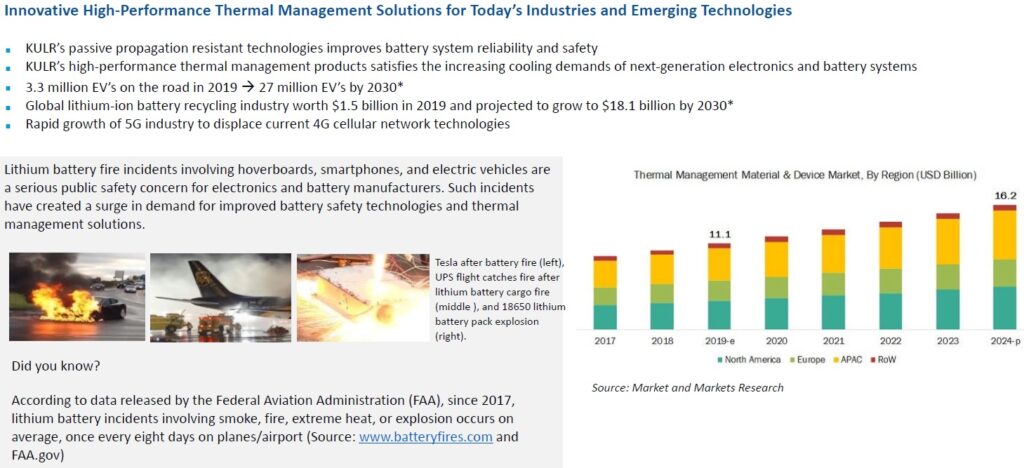
KULR Could Have More Upside Than Any Other 5G Stock

5G Stocks Prices are on the Up
Demand for high-performance passive cooling solutions in the rapidly growing 5G and cloud computing industries is increasing. KULR is collaborating with Tier-1 companies in the 5G infrastructure and cloud computing spaces to design and develop cooling solutions that enhance performance and safety standards.
• The 5G infrastructure market size is forecasted to be worth $496.6 billion by 2027 with a CAGR of 106.4%*
• The global cloud computing market size was valued at $266 billion in 2019 with a CAGR of 14.9% from 2020 to 2027*
KULR’s proprietary suite of thermal interface materials have characteristics that collectively are of particular importance to the 5G infrastructure and cloud computing industries:
• High bulk thermal conductivity
• Low interfacial resistance at relatively low contact pressures
• High electrical conductivity for electromagnetic shielding
• Exceptionally lightweight and compliant (form-fitting)
• Industrial-level reliability
Innovation Drives Long-Term Shareholder Value For KULR Investors
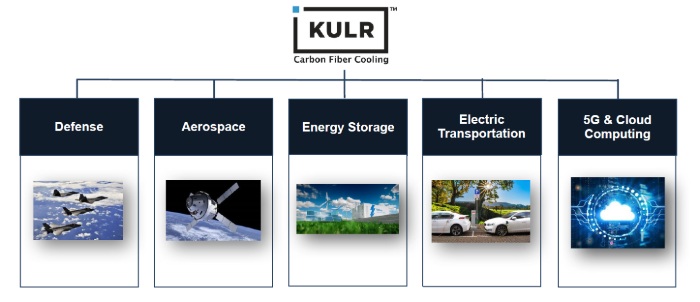
The Bullish Case For KULR Technology Group Inc. (OTCQB: KULR)
- The Float Is Razor Thin
- Chart Is Trending Bullish
- Substantial Market Opportunities
- Substantial Market Opportunities
- Strong Revenue Growth
The Bottom Line:
With its low-float and recent announcements, we believe that KULR is in for a huge week of trading.
The Company is in the midst of a major growth period, and we believe it has the potential to double in price from here.
KULR already has strong revenue growth, and is in possession of cutting edge technology in some of the fastest growing tech sectors.
With a analyst price target of $5.00, we believe that KULR is extremely undervalued at its current levels.
Learn More About KULR As News Comes Out at Your Preferred Brokerage Firm
This report is for information purposes only and is neither a solicitation or recommendation to buy nor an offer to sell securities. Financials Trend is not-a-registered-investment-advisor. Financials Trend is not a broker-dealer. Information, opinions, and analysis contained herein are based on sources believed to be reliable, but no representation, expressed or implied, is made as to its accuracy, completeness or correctness. The opinions contained herein reflect our current judgment and are subject to change without notice. Financials Trend accepts no liability for any losses arising from an investor’s reliance on the use of this material. Financials Trend has been compensated 5.5k for coverage of this stock by EMD Media for this week. Financials Trend and its affiliates or officers currently hold no shares of this stock. Financials Trend and its affiliates or officers will purchase and sell shares of common stock of these stocks, in the open market at any time without notice. Financials Trend will not update its purchases and sales of these stocks in any future postings on Financials Trend’s websites. Certain information included herein is forward-looking within the context of the Private Securities Litigation Reform Act of 1995, including, but not limited to, statements concerning manufacturing, marketing, growth, and expansion. The words “may”, “would,” “will,” “expect,” “estimate,” “anticipate,” “believe,” “intend,” ” project,” and similar expressions and variations thereof are intended to identify forward-looking statements. Such forward-looking information involves important risks and uncertainties that could affect actual results and cause them to differ materially from expectations expressed herein. *Financials Trend does not set price targets on securities. Never invest into a stock discussed on this web site or in this email alert unless you can afford to lose your entire investment.





